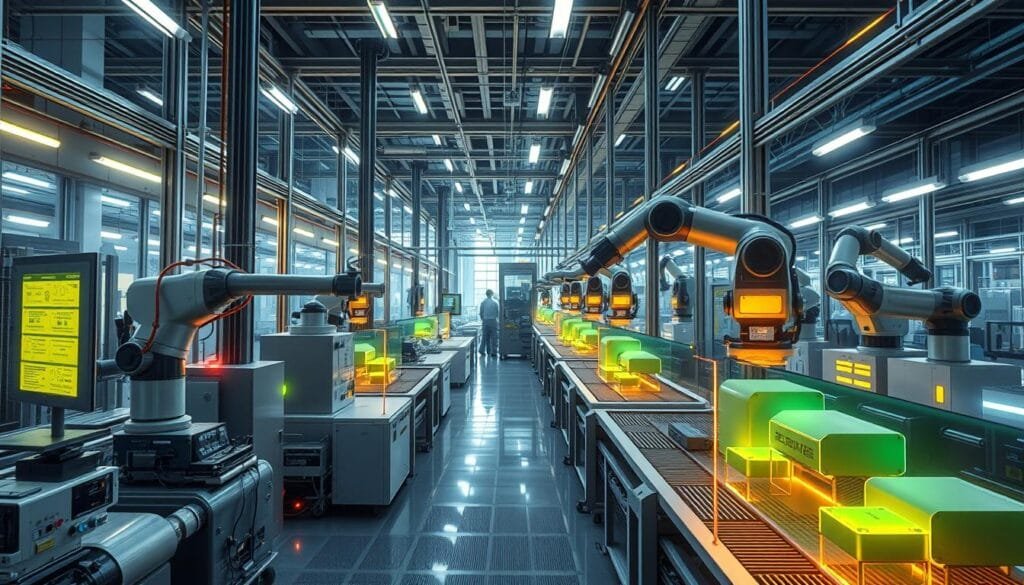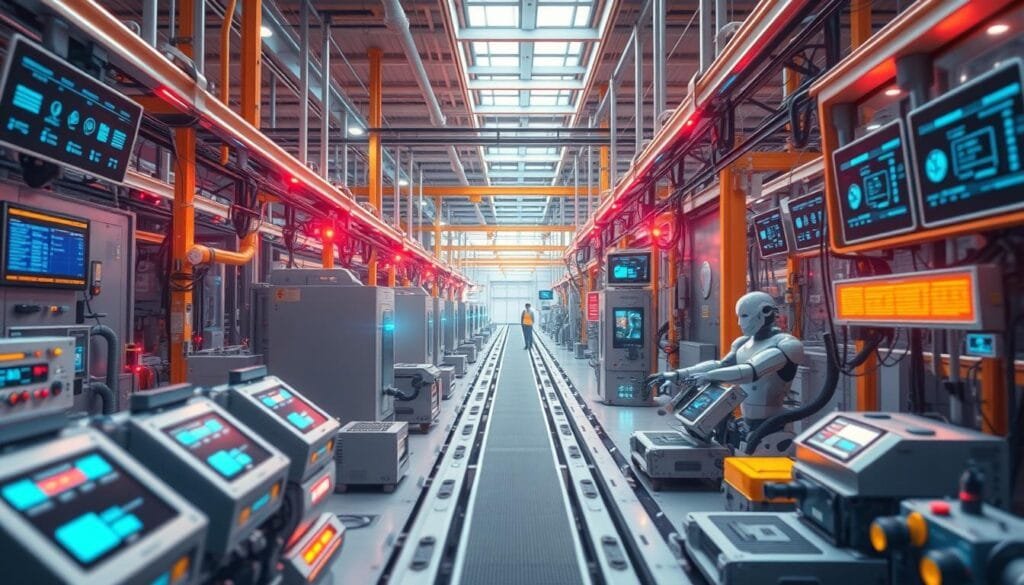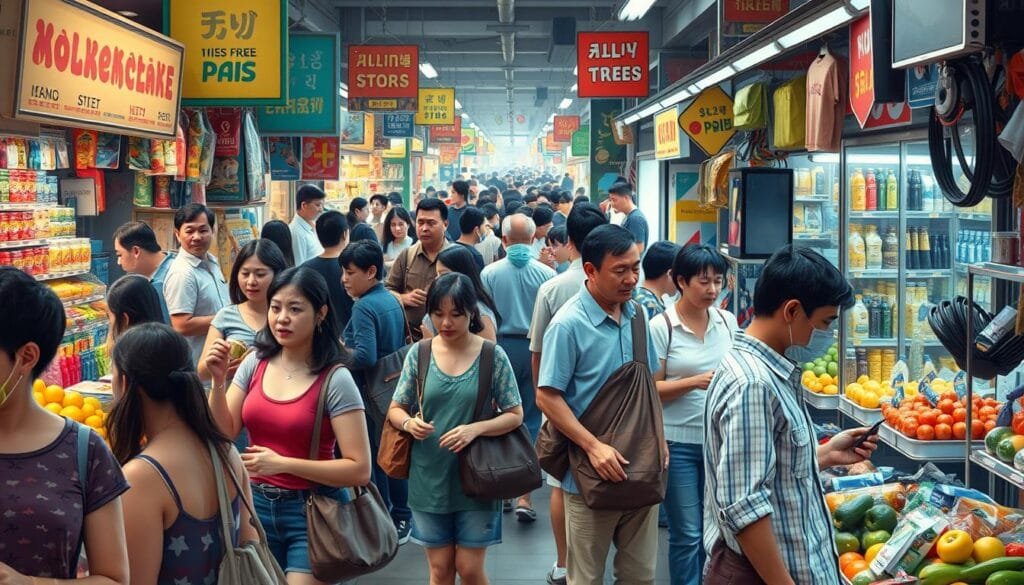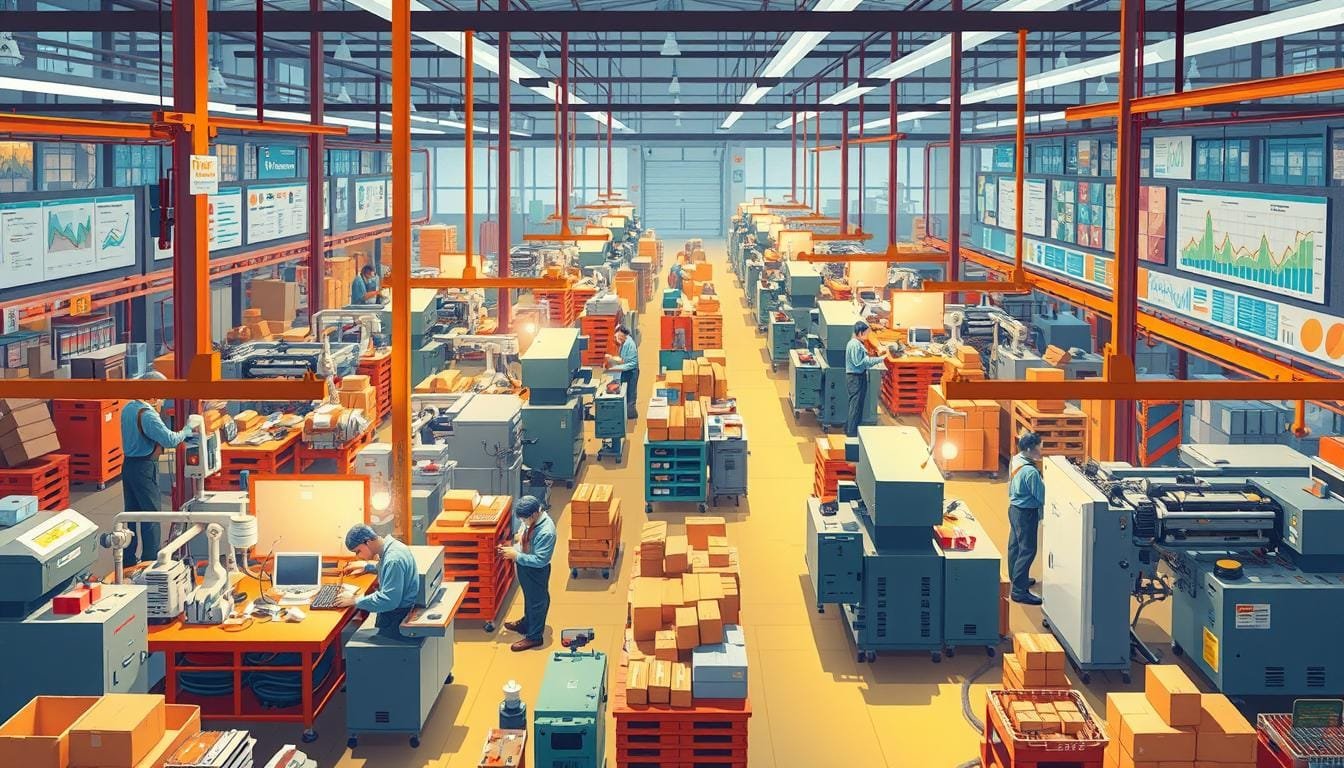What if the success of our economy rests on understanding the dance between land, labor, and capital? This is a vital concept.
Production Process Economics looks at how goods and services are made. It focuses on the mix of raw materials and non-material aspects like knowledge. Understanding production theory helps us see how consumer behavior affects economic production. By looking into production economics, we grasp how these elements help maximize economic welfare. The created value links directly to the utility for individuals and the economy. This shows its crucial role in boosting GDP through better market production.
The sorting of production factors into land, labor, capital, and entrepreneurship shapes any production process. Efficiency is key. It’s the potential output over the actual input. If it’s 60% or more, it affects our economic direction. Market production is essential for generating and sharing income among stakeholders. As the price-quality ratio of commodities improves, competitiveness grows. Stakeholders like producers, customers, and suppliers watch these trends closely.
Economic growth often comes from higher incomes, thanks to more efficient, growing market production. Production behaviors change over time, tied to consumption trends that also impact productivity. Technological advancements have reshaped production since the industrial revolution. This shows a path to better productivity when production outpaces consumption.
Stakeholders’ interests, economies of scale, and external pricing’s ongoing impact decide the viability and scale of any production process. These elements highlight the dual role of market production. It not only creates goods and services but also generates income. This helps reinforce overall economic well-being.
Key Takeaways
- Production Process Economics studies the interaction of various inputs in creating goods and services.
- The efficiency ratio is a crucial measure, calculated as the maximum potential output divided by actual input.
- Market production uniquely generates and distributes income to stakeholders.
- Economic production is influenced by technological advancements and consumption trends.
- Factors of production economics include land, labor, capital, and entrepreneurship.
- Growth in productivity often results from increased and more efficient market production.
- Stakeholders in production processes are categorized based on their economic interests: producers, customers, and suppliers.
What is the Production Process Economics?
Production process economics is about how resources turn into economic output. It looks at the input-output relationship in production. This insight helps improve efficiency and effectiveness in production.
Introduction to Production Theory
Production theory examines the input-output relationship fundamental to all production. It studies how land, labor, and capital create economic output. These inputs work together to produce valuable goods and services, boosting the economy.
Primary and Secondary Factors of Production
Land, labor, and capital are primary factors in production. These undergo little change but are vital for economic output. Secondary factors like materials and energy come from primary inputs. Optimizing these inputs is crucial for maximum output.
Market, Public, and Household Production
Market, public, and household productions play distinct economic roles. Market production makes and distributes income. Public production supplies goods and services not efficiently provided by the market.
Household production adds to life quality and economic stability. These production types relate to the input-output relationship. They ensure we meet human needs and offer quality services and goods at good prices.
| Factor Type | Elements | Role in Production |
|---|---|---|
| Primary Factors | Land, Labor, Capital | Fundamental inputs with minimal transformation |
| Secondary Factors | Materials, Energy | Derived from primary inputs, utilized in transformation |
| Market Production | Goods and Services | Generates economic output, distributes incomes |
| Public Production | Public Goods | Supply services efficiently unsupplied by the market |
| Household Production | Domestic Services | Contributes to quality of life, economic stability |
Efficiency in Production Processes
Achieving production efficiency is crucial in today’s manufacturers. By maximizing output and using resources well, companies can save costs and boost productivity. Let’s look into what makes production processes efficient.
Maximizing Output
To maximize output, every part of the production process must be improved. This ensures goods are made quickly and well. A key measure is the capacity utilization rate. It shows what part of a factory’s total capacity is used.
For instance, if a factory can make 10,000 units but only makes 8,000, its capacity utilization is 80%. Another important measure is the Overall Equipment Effectiveness (OEE) score. A 76% OEE means 76% of the time was used well, but 24% was lost to inefficiencies.

Technological Advancements
Technology is key to making production more efficient. New machinery and automation cut downtime and boost productivity. These tools lower errors, make processes smoother, and improve resource use.
Using Manufacturing Execution Systems (MES) and Enterprise Resource Planning (ERP) gathers data in real time. This helps make better decisions. Also, arranging the production area well can reduce unnecessary movement and time waste, increasing efficiency.
- Capacity Utilization: 80%
- OEE Score: 76%
- Yield rate: 95%
- Cycle Time Efficiency: 60%
Economies of Scale
Economies of scale mean the more you produce, the cheaper it gets per unit. Growing production lets companies save by buying raw materials in bulk, using labor better, and using technology more. This lowers costs per unit. These benefits increase efficiency.
Regularly checking processes can spot inefficiencies. This lets companies adjust fast to stay ahead. Overall, how well a company uses its inputs to make outputs is vital for efficiency.
| Efficiency Metric | Value |
|---|---|
| Capacity Utilization Rate | 80% |
| OEE Score | 76% |
| Yield Rate | 95% |
| Cycle Time Efficiency | 60% |
The Role of Technological Changes
Technological changes have hugely impacted production economics. They’ve reshaped our understanding of productivity and changed how we produce goods.
Historical Influence of Technology
The impact of technology over history is transformative. The Industrial Revolution is a prime example of this. It showed how new technologies could deeply change how we make things.
The rise of technology led to big economic growth and more productivity. For instance, the Solow Residual method shows a lot of economic growth comes from technology, beyond just capital and labor.

Innovations like the steam engine and the assembly line have reshaped production. Henry Ford’s use of the assembly line revolutionized how we mass-produce, making it much more efficient.
Current Technological Trends
Today, technology continues to change how we produce things. Automation, AI, and digital transformation are setting new standards. Automation and AI, in particular, make it possible to handle complex data and make decisions in ways we couldn’t before.
Complexity science tools help us analyze social phenomena better than old economic tools did. Emphasizing open innovation has increased collaboration. This is between schools, research groups, and businesses, pushing technology forward.
Big investors are focusing on things like automated driving, big data, 3-D printing, and more. This push for innovation relies on both well-documented knowledge and the kind that’s harder to pinpoint, like what we get from patents and scientific papers.
Innovation spread and adoption are also key. For instance, if a technology fits easily into people’s lives, it’s more likely to be widely used. Being able to try out new technology increases its adoption by 30%. Also, seeing others use a technology can make it 50% more likely for someone to adopt it. This shows how important the social side of technology use is.
These trends in technology are shaping the future of how we create things. They highlight the need for ongoing innovation to keep up in a competitive world and solve complex problems.
The Impact of Consumer and Producer Behavior
It’s important to know how consumer actions and producer plans affect production economics. Consumer choices, together with how goods are made and sold, shape how much and what gets produced. This also decides how well the economy does.
Pricing methods are key in deciding if producing something is worthwhile. They also help companies stand out in the market. By understanding these behaviors, we can better predict market trends. This helps in planning production and marketing, leading to better economic results.
Behaviors Influencing Productivity
Consumer spending makes up about 70% of the U.S. GDP. This highlights the huge role consumer behavior plays in the economy. When people spend more, GDP goes up. This is good for businesses and workers.
But, some tactics like making things that don’t last can hurt competition. Also, buying a lot for the sake of it can waste resources. This doesn’t add value to the economy. Understanding these patterns helps us see their effect on economic health.
Studies on psychology show how buying things affects us. People equating what they own with their value often feel less happy. And focusing too much on buying can lead to more stress and sadness. This behavior is seen when new phones come out yearly, pushing us to upgrade. Events like Black Friday also show how strong these shopping habits can be.

Supply and Demand in Production
The balance between supply and demand is crucial in understanding how markets work. Measures of consumer confidence help us see if demand is strong. This affects how much is produced, impacting GDP and economic health.
As demand goes up, producers make more to keep up with the market. This shows why businesses must always watch these trends. Staying competitive and meeting market demands is essential.
Pricing and its Effects on Production
Setting the right prices is very important in economics. Prices influence how much people buy and whether making something is profitable. Businesses need to find a sweet spot with their prices. They must cover costs while attracting customers.
Getting pricing right helps a company stay competitive during ups and downs in the market. Companies good at this are more likely to succeed. This highlights the big role of pricing in the health of a business.
| Key Indicator | Impact on Production |
|---|---|
| Consumer Spending (70% of GDP) | Increases GDP, boosts business and worker prosperity. |
| Planned Obsolescence | Decreases product durability, affects competition. |
| Conspicuous Consumption | Can lead to negative-sum economic activity. |
| Consumer Confidence | Indicates healthy demand, influences production levels. |
| Pricing Strategies | Determine competitiveness and production viability. |
Conclusion
As we wrap up our talk about Production Process Economics, we see why knowing the *economic production* ideas matters. It’s important for those who want to make things better and boost welfare. By looking into the production function and what it involves, we learn a lot. We learn how labor and capital come together to push out products and make the economy grow.
Understanding both fixed and variable inputs is key in production. Also, knowing how diminishing marginal productivity affects things is crucial. These aspects shape how we plan to make things. The formula y = f(x1, x2; k) shows how changing inputs affects what we produce. Also, tech like AI and robotics has really changed how we make things. This has made us more productive and cut costs.
To sum up, looking deeply into how things are made can help us find better ways to improve goods and services. This can also help us make society more productive. By using what we learn from theories, tech, and how people behave economically, we can build a stronger economy. This leads to growth and a better life for everyone.
FAQ
What is production theory?
Production theory is about understanding how businesses turn resources into products. It looks at how labor, money, and materials come together to make goods. This helps explain the goods we see and buy every day.
What are the primary and secondary factors of production?
The main factors in production are natural resources, work, and capital. These are directly involved in making goods. Then there are secondary factors like tech and entrepreneurship. They make the primary factors work better, boosting productivity.
What is the difference between market, public, and household production?
Market production is all about making goods for sale. Public production is what the government or public sector provides. Household production includes what we produce at home, often not for sale.
How can businesses maximize output?
To produce more, businesses need to use their resources well. They should also use effective production methods and the latest tech. Getting better at what they do and training their people also helps a lot.
What role do technological advancements play in production efficiency?
Tech advancements make producing things more efficient. They automate steps, cut waste, and ensure quality. New machines, software, and methods let businesses do more with less.
What are economies of scale?
Economies of scale mean making things cost less by producing more. When production goes up, the cost per item goes down. This happens because of buying in bulk, having specialized workers, and better use of equipment.
How has historical technology influenced production?
Tech changes in history, like the Industrial Revolution, totally changed how we make things. It brought in machines and mass production. This made more goods, cut costs, and helped industries grow all over.
What are current technological trends in production?
Today, tech trends include automation, the Internet of Things (IoT), artificial intelligence (AI), and advanced robotics. These innovations improve how accurate, efficient, and adaptable production is.
How do consumer and producer behaviors influence productivity?
What consumers and producers do impacts how productive we are. It changes the demand for goods and services and how we make them. Being smart about what and how we produce is key for staying productive.
What is the role of supply and demand in production?
Supply and demand control how much we produce and the price. More demand can mean more production and maybe higher prices. Too much supply can lower prices and cut the incentive to produce.
How does pricing affect production?
How we price things can change how much gets sold and the profits. Low prices may increase sales, while high prices can make goods seem better. These strategies play a big role in planning what to produce.
